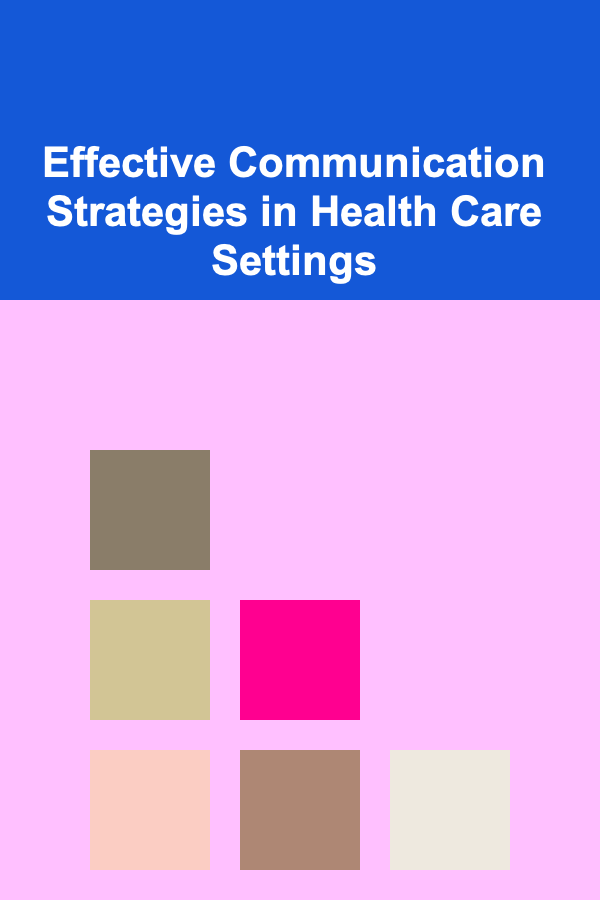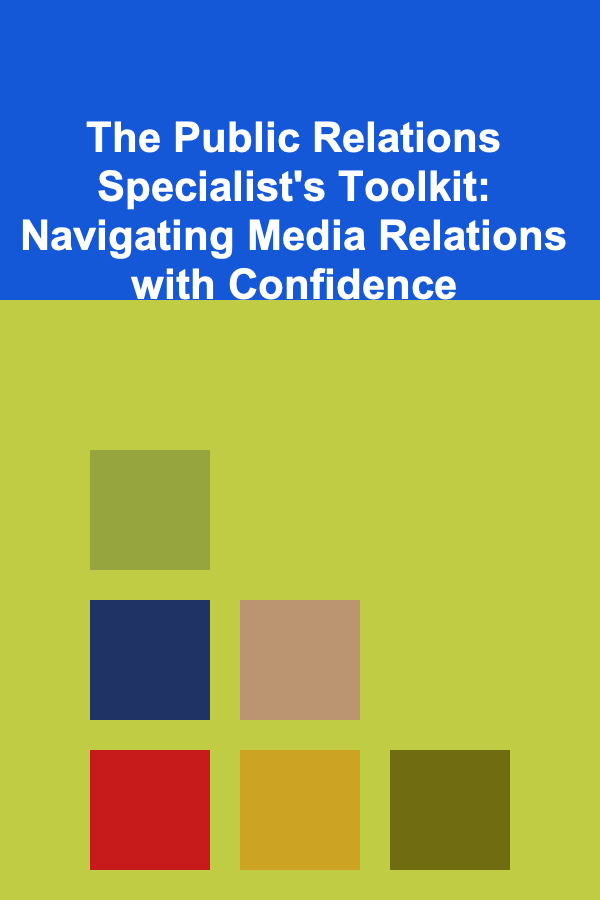
Effective Communication Strategies in Health Care Settings
ebook include PDF & Audio bundle (Micro Guide)
$12.99$11.99
Limited Time Offer! Order within the next:

Effective communication in health care is not only about exchanging information---it is a vital element of quality patient care, staff efficiency, and patient safety. In healthcare settings, where the stakes are high, clear communication can mean the difference between life and death, accurate diagnoses, or the avoidance of costly mistakes. This article explores actionable strategies for improving communication in health care settings to ensure better patient outcomes, smoother operations, and stronger relationships between patients and providers.
Understanding the Importance of Communication in Health Care
Communication in healthcare is multi-dimensional and extends beyond verbal exchanges. It involves non-verbal cues, written communication, technology usage, and cultural sensitivity. Effective communication helps healthcare professionals:
- Build trust with patients, fostering a positive therapeutic relationship.
- Ensure patient safety by avoiding misunderstandings that could lead to medical errors.
- Improve patient satisfaction by making patients feel heard, respected, and involved in their own care decisions.
- Enhance teamwork among healthcare professionals, enabling better collaborative care.
However, communication in healthcare can be complicated by various factors such as medical jargon, time constraints, cultural differences, language barriers, and technology. Overcoming these challenges requires intentional, systematic efforts to improve communication across all levels of the healthcare system.
Strategies for Effective Communication in Health Care
1. Active Listening
Active listening is a cornerstone of effective communication in healthcare. It involves fully concentrating, understanding, responding, and remembering what is being said. For healthcare professionals, this means not only hearing the words but also interpreting the meaning behind them, which is crucial for making accurate diagnoses and developing effective treatment plans.
Actionable Tips:
- Maintain Eye Contact: Establish rapport and show that you are focused on the speaker.
- Give Full Attention: Avoid distractions (e.g., looking at a phone or computer screen). Make the speaker feel that their message is important.
- Ask Clarifying Questions: Instead of making assumptions, ask for clarification when unsure about the patient's concerns.
- Paraphrase and Summarize: This allows you to check for understanding and ensures that you and the patient are on the same page.
2. Use of Plain Language
Medical jargon and complex terminology can confuse patients, leading to misunderstandings. Using plain language---terms that are simple and easy to understand---is crucial in enhancing patient comprehension. The goal is to explain medical concepts in a way that patients can grasp, enabling them to make informed decisions about their care.
Actionable Tips:
- Avoid Complex Terminology: Use terms that patients can easily understand, and explain any technical terms if their usage is necessary.
- Use Analogies: Relate medical concepts to everyday situations. For instance, explaining blood circulation as a "highway system" can help make the idea more relatable.
- Check for Understanding: Ask the patient to explain the information back to you in their own words. This ensures that they've fully understood.
3. Non-Verbal Communication
Non-verbal communication includes body language, facial expressions, tone of voice, and gestures, which all play a crucial role in healthcare settings. A healthcare provider's non-verbal cues can reinforce or contradict their spoken message. Being mindful of these cues is essential for ensuring that the patient receives consistent and accurate information.
Actionable Tips:
- Be Aware of Your Body Language: Ensure that your posture, facial expressions, and gestures are welcoming and open. Negative body language, like crossed arms, may give the impression of disengagement.
- Use Open and Calm Gestures: When delivering important information, keep your hands relaxed, and maintain an approachable posture.
- Tone of Voice Matters: A warm, calm, and reassuring tone can help alleviate patient anxiety, while a hurried or dismissive tone can foster mistrust.
4. Empathy and Compassion
Empathy is the ability to understand and share the feelings of others, while compassion involves taking action to help alleviate another's suffering. In healthcare, empathy can build a trusting relationship and improve patient outcomes. Patients who feel heard and understood are more likely to adhere to treatment plans and have better mental and emotional well-being.
Actionable Tips:
- Validate Patient Feelings: Acknowledge the patient's emotional state by saying things like, "I can see this is difficult for you," which shows understanding.
- Use Reflective Statements: Reassure patients by saying, "It seems like you're feeling anxious about this procedure. Let's talk through it together."
- Be Present: Give the patient your undivided attention and allow them to express their feelings without rushing them.
5. Cultural Competence and Sensitivity
Healthcare providers must be aware of cultural differences and how they can affect communication. Culture influences how people perceive health, illness, and treatment, and it shapes their communication styles. Culturally competent communication means respecting the patient's cultural preferences and adapting to their needs.
Actionable Tips:
- Ask About Cultural Preferences: Don't make assumptions about a patient's beliefs. Ask them about their cultural practices or preferences and how these might affect their treatment.
- Be Open to Learning: Continuously educate yourself about the cultures of the patients you serve. Attend workshops, seminars, or engage in training that broadens your understanding of different cultural perspectives.
- Avoid Stereotyping: Every patient is unique. Avoid making assumptions based on ethnicity, race, or religion.
6. Use of Technology and Digital Tools
Technology has revolutionized healthcare, but it also poses unique challenges to communication. Electronic health records (EHRs), telemedicine, and patient portals can improve communication but also present barriers, such as technological literacy or the lack of face-to-face interaction.
Actionable Tips:
- Ensure Accessibility: Make sure that all digital tools and platforms are accessible to patients of varying technological skills. Provide training or assistance if necessary.
- Follow Up Using Technology: After an appointment, send patients follow-up information through text, email, or patient portals to ensure they have a clear understanding of the next steps.
- Use Telemedicine Effectively: In telemedicine consultations, ensure clear audio and visual quality. Always check if the patient is comfortable with the technology and offer assistance if needed.
7. Patient-Centered Communication
Patient-centered communication focuses on the needs, preferences, and values of the patient. It is a model that prioritizes the patient's experience, empowering them to actively participate in their own care. This approach improves trust, compliance, and patient satisfaction.
Actionable Tips:
- Engage in Shared Decision-Making: Involve the patient in decisions about their treatment plan. Ask for their input and collaborate on setting goals that align with their values.
- Respect Autonomy: Respect the patient's right to make their own healthcare decisions, even if their choices differ from your recommendations.
- Create a Safe Environment for Questions: Encourage patients to ask questions. Provide answers that are clear, non-judgmental, and informative.
8. Addressing Language Barriers
Language barriers can significantly hinder effective communication, especially in a multicultural society. Providing interpretation services is vital for ensuring that non-English-speaking patients receive equitable care.
Actionable Tips:
- Utilize Professional Interpreters: Use certified medical interpreters when necessary to ensure accurate communication. Avoid using family members, as they may not be able to convey medical information accurately.
- Provide Multilingual Materials: Ensure that important patient education materials, consent forms, and discharge instructions are available in multiple languages.
- Use Simple Visual Aids: In some cases, pictures or visual aids can help convey medical information to patients who may not speak the same language.
9. Building a Communication-Friendly Environment
The physical environment plays a role in facilitating effective communication. A well-organized, comfortable space can help reduce patient anxiety and encourage open dialogue. For healthcare teams, having structured communication systems in place can streamline information sharing.
Actionable Tips:
- Create a Calm and Private Setting: Ensure that patients can speak openly without fear of being overheard, and create an environment that minimizes distractions.
- Utilize Checklists and Protocols: In clinical settings, use standardized communication tools like SBAR (Situation, Background, Assessment, Recommendation) to ensure important information is passed clearly and efficiently during handoffs.
- Encourage Open Team Communication: Regularly engage in team meetings or huddles where important information is shared, and issues are addressed collaboratively.
10. Feedback Loops
Establishing feedback loops allows healthcare providers to assess the effectiveness of their communication. This helps identify areas of improvement and fosters a culture of continuous learning.
Actionable Tips:
- Conduct Patient Satisfaction Surveys: Regularly survey patients about their experience, specifically regarding communication. Analyze responses to identify patterns and areas for improvement.
- Foster Open Dialogue Among Staff: Create an environment where healthcare workers feel comfortable providing feedback to one another on communication practices.
- Reflect on Communication Practices: Periodically assess your own communication style. Are you using language that's clear and empathetic? Are you making an effort to actively listen? Reflecting on these questions can help improve your overall communication skills.
Conclusion
Effective communication in healthcare is not just about talking---it's about listening, understanding, and respecting the perspectives of patients, families, and colleagues. It requires a thoughtful approach, involving active listening, empathy, and cultural sensitivity, and is essential for ensuring that patients receive the best care possible. By implementing these strategies, healthcare organizations can significantly improve patient outcomes, increase satisfaction, and foster a more positive and collaborative environment for both patients and staff. Ultimately, effective communication is at the heart of quality healthcare delivery.

How to Design a Planetary Defense System
Read More
How to Design a Spring Cleaning Checklist for Your HVAC System
Read More
How to Start Investing in Startups and Early-Stage Companies
Read More
How to Use Technology to Simplify Donation Management
Read More
How to Use Technology to Simplify Your Financial Planning
Read More
The Public Relations Specialist's Toolkit: Navigating Media Relations with Confidence
Read MoreOther Products

How to Design a Planetary Defense System
Read More
How to Design a Spring Cleaning Checklist for Your HVAC System
Read More
How to Start Investing in Startups and Early-Stage Companies
Read More
How to Use Technology to Simplify Donation Management
Read More
How to Use Technology to Simplify Your Financial Planning
Read More